Morning Splash: The Top Seven Performances From the NCAA Swimming Championships
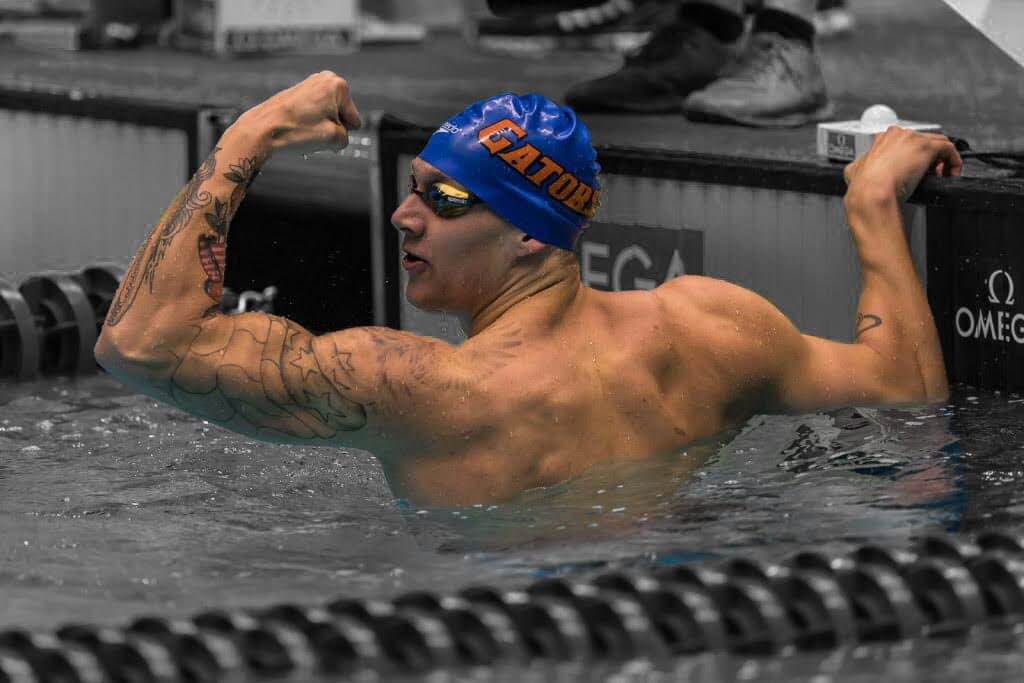
Editorial content for the 2018 NCAA DI Championship coverage is sponsored by TritonWear. Visit TritonWear.com for more information on our sponsor. For full Swimming World coverage, check event coverage page.
By David Rieder.
Take a deep breath. Over the past two weeks at the women’s and men’s NCAA swimming championships in Indianapolis, the American and/or NCAA record went down in 14 PLUS events as the Stanford women and Texas men stormed to dominant team championships.
You’ve seen the times and what it all meant to the athletes competing front and center. If you haven’t, you should check out our landing pages for the women’s and men’s meets, where you can find immediate recaps, commentaries, video interviews, analyses and photos.
Over the next three months, the top performers from NCAAs will move their focus to the long course pool, trying to carry over their success towards U.S. Nationals in the very same IUPUI Natatorium in three months’ time and the World Championships coming up in late July in Budapest.
There will be plenty of time to dig deep into that short course to long course analysis, but as the last swimmers and coaches head home from Indy, why not look back at the top performances from the past two weeks of racing?
Some of these swims were record-breaking efforts but not all. And to be sure, plenty of excellent candidates just missed the cut-line of seven.
7. Lilly King, Indiana – 200 Breast (2:03.18)
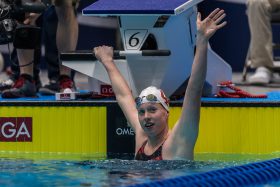
Photo Courtesy: Peter H. Bick
Lilly King expected that she would have no real competition in the 100 breast, and she came out flat (by her standards) for that event. She finished in 56.71, the second-fastest time in history, but in her own words, the swim “sucked.”
One day later, she had to deal with Minnesota’s Kierra Smith in the 200 breast. Smith had been a 2016 Olympic finalist in the event, and King knew she needed to get her mojo back in time to face her first-ever challenge in an NCAA breaststroke event.
Indeed, King responded. Smith made up a big lead over the final 100 yards and touched in 2:03.55, under King’s old NCAA record of 2:03.58, but King got to the wall a few tenths ahead, in 2:03.18.
6. Will Licon, Texas – 400 Medley Relay breast split (49.75)
Photo Courtesy: Peter H. Bick
Really, the whole relay deserves a spot on this list as the Texas Longhorns became the first team to break the 3:00-barrier in the 400 medley relay. John Shebat stuck with Cal’s Ryan Murphy on the backstroke leg, but Licon broke the race wide open.
Just more than an hour after he won the 200 IM but in a time far from what was expected (1:40.67), Licon rocked a 49.75 breaststroke split that ranks as the fastest in history. Joseph Schooling and Jack Conger had no trouble closing out the relay from there.
The man won three individual events on the weekend, including the first ever sub-1:48 swim in the 200 breast, but none was more impressive than that relay split. None meant more, either.
5. Mallory Comerford, Louisville – 200 Free (1:40.36)
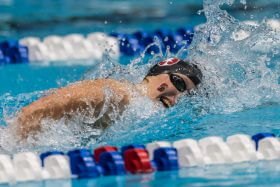
Photo Courtesy: Peter H. Bick
No, it was not an American or NCAA record, and no, Mallory Comerford did not even touch the wall first outright. But the Louisville sophomore deserves some credit for her breakthrough moment.
She touched in 1:40.36, dead-heated with Olympic gold medalist Katie Ledecky. The two moved to No. 2 on the all-time list in the event.
But Comerford gets the nod here because of her race plan. Ledecky tried to stick with Simone Manuel on the first 200 and ended up not having her signature finishing kick left to turn to. Comerford swam behind the two Stanford swimmers for most of the race before coming home in 25.53, faster than even Ledecky.
Comerford was patient and stuck to her race plan, and it paid off with a best time by almost a second and a half. And, you know, an NCAA title.
4. Katie Ledecky, Stanford – 500 Free (4:24.06)

Photo Courtesy: Peter H. Bick
Come on, you had to figure Ledecky would make it onto this list eventually, and the 500 free was by far her most impressive swim of her first collegiate national championships.
When Ledecky first set the American record in the 500 free, she posted a time of 4:29.54. Entering her freshman season at Stanford, her top mark was 4:26.58, set at a high school championships in 2015. She then lowered the mark three times, to 4:26.54 (at the Ohio State Invite), to 4:25.15 (at the Pac-12 championships) and then to 4:24.06 in Indy.
Finishing second in that race was Leah Smith, who came in at 4:28.90, becoming only the second woman to ever break 4:30. Smith’s time was impressive enough that it merits a mention if this list had run a little bit longer, and yet she still was almost five seconds behind Ledecky, who has single-handedly brought the 500 free to an insane new level.
3. Clark Smith, Texas – 1650 Free (4:08.42)
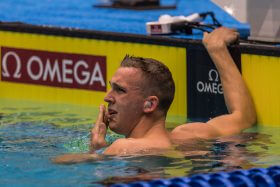
Photo Courtesy: Peter H. Bick
Clark Smith is not afraid of pain. He showed that in the 400 free final at Olympic Trials, going out well under world record pace before fading badly down the final 100 yards.
He was not afraid in the NCAA final of the 500 free, either, going out quick with the knowledge that teammate Townley Haas and the rest of the pack would close him down on the last 100. He won that race in 4:08.42, a new American and NCAA record—very nearly getting a spot on this list based on those merits.
But no race at the men’s meet could match what Smith pulled off in the 1650. He was in pain even before the race, having strained his groin during the 500 free. It would have been easy to quit or cruise, particularly with Felix Auboeck, Akaram Mahmoud and Jordan Wilimovsky all swimming faster than any man ever had.
But Smith would not give in. He could not stand up after the race, but that didn’t stop him from kicking with everything he had on the last 50 to pull just ahead and take the victory. He broke Connor Jaeger’s American record by more than a second, touching in 14:22.41.
After the race, meet announcer Sam Kendricks called the swim the greatest he had ever seen. And Smith won it.
2. Simone Manuel, Stanford – 100 Free (45.56)
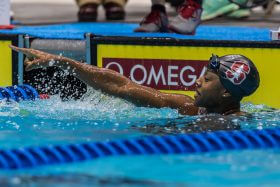
Photo Courtesy: Peter H. Bick
Hard to top Smith’s mile, but two people did it—one at the women’s meet and one at the men’s, and both in the same event.
Simone Manuel did not have the flashiest meet prior to her 100 free at the women’s NCAA championships. She had won the 50 free and finished third in the 200 free but was generally overshadowed by her own teammates, particularly Ledecky and Ella Eastin.
But on the meet’s final day, Manuel came out and crushed her own American record in the 100 free, posting a time of 45.56 to break her 46.08 from two years earlier by more than a half-second.
When Manuel won Olympic gold in the 100 free over the summer, expectations automatically rose for her return to collegiate swimming. Maybe that means her exploits in the 50 and 200 and on relays—very much up to her usual standard—were not appreciated as much as they should have been.
But when she swam that 45.56, everyone took notice.
1. Caeleb Dressel, Florida – 100 Fly (43.58)
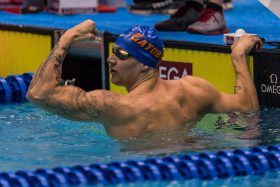
Photo Courtesy: Peter H. Bick
When Olympic gold medalist Joseph Schooling turned for home in the 100 fly final with a huge lead, his third-consecutive NCAA title in the event seemed all but a forgone conclusion, even if Florida’s Caeleb Dressel was not far away.
But off the last wall, it was Dressel who kicked away. He did not breathe on the last 25 and came into the wall in 43.58, crushing Tom Shields’ American record of 43.84. Schooling, too, beat Shields’ old mark, but he could only watch as his former Bolles teammate celebrated his stunning defeat.
But as stunning as was Dressel’s massively successful foray into the butterfly world, it’s impossible to top what he accomplished in the 100 free.
40.00. Just think how ridiculous that time is, three-quarters of a second faster than anyone else has ever swum. He even left Olympic gold medalist Nathan Adrian in awe. A potential sub-40 performance sounded so far out there, but it wasn’t. (Just imagine if Dressel had worn a dome cap!)
Before the final night of competition at the men’s meet, Manuel had the inside track on the No. 1 spot on this list, and Dressel’s 100 fly had him ranked second.
But then came the 40.00.
All commentaries are the opinion of the author and do not necessarily reflect the views of Swimming World Magazine nor its staff.




.jpg)
If I read it correctly, I believe the Editor needs to fix the #3 banner. Clark Smith finished the 1650 in 14:22:41
The announcer said Clark Smiths 1650 was the best race he had ever seen in his life. The announcer is the one that does all he big nation events…
Actually, the fastest 100 breaststroke relay split is not Licon’s 49.75, but Kevin Cordes’s 49.56 from 2013. Licon’s is the second fastest ever.
I guess if during the course of her initial NCAA season Ledecky hadn’t already re-written the record books by setting eight other American Records across 5 individual events including the 400 IM, and 12 NCAA records, and 7 Stanford team records and 3 pool records at CAL’s POOL including in back-to-back events, and maybe if she hadn’t already brought her 1650 Free American record down by 10 seconds (at the OSU Invitational in November!) maybe, just maybe, she would’ve been on this list three or more times and perhaps at a higher spot. Guess that anchoring two American Record-setting 800 Free Relays in the space of three weeks (Pac-12s and NCAAs) including a 1:40 200 Free split doesn’t count for much either these days. Or being the first woman in three decades to win 200-500-1650 Free NCAA titles while winning more events (5) than any woman at NCAA’s and while setting/participating in 3 ARs. Funny too, I don’t see CSCAA’s Div. 1 “Swimmer of the Year” Kathleen Baker anywhere on this list. Hmmmm.
Must not have fulfilled “expectations” this time. Or maybe it’s because Baker has never broken an AR in two NCAA seasons or in her career.
What eight American records in five individual events? Are you sure about that? Can you be more specific? There were no American records neither in 200 free nor in 1000 free during her freshman year in Stanford.
Sorry, a slight inaccuracy crept in because it is hard to calculate given that Ledecky has broken 13 World Records and 30 American Records in her career, and she broke so many American records this NCAA season. Newsflash–Baker still has NONE. For this NCAA season, it is more accurate to say it was cumulatively 9 ARs and 12 NCAA records and 4 NCAA Championship meet records for Ledecky, across 6 total events and those records (ARs & NCAA records combined) were set across four of the five major individual events swum by Ledecky this season. Ledecky broke the 500 Free AR and NCAA record three separate times, bringing it down to the “insane” level noted in the article where the second fastest swimmer remains almost 5 seconds behind her. She broke her own 1650 Free American Record by nearly 10 seconds, eclipsing the prior NCAA record by about 24 seconds and did that in-season, and then won the race at NCAAs by more than 20 seconds. She broke the 400 IM American record in a Pac-12 championship race, besting the now two-time NCAA champ in the event and current AR holder, Ella Eastin. Ledecky broke the NCAA record in the 1000 Free twice–as splits, but no big deal!! Ledecky was on 4 AR and NCAA record breaking relays, 2 times in the 800 Free relay and 2 times in the 400 Free relay, anchoring the 800 Free relay both times, once with a 1:40.4 split for the 200 Free. She beat Olympic gold medalists, including sprinter Simone Manuel and two-time defending NCAA champ Leah Smith, in her individual races at NCAAs. She outsplit Baker on both relays in which they overlapped, both won by Stanford. Ledecky broke 7 Stanford team records in 7 different events during the season, in the 200-500-1000-1650 Frees, the 400 IM and the two relays, breaking Janet Evans’ team records (which had stood for 17 years) by 35 seconds in the 1650 Free and 10 seconds in the 500 Free. Ledecky broke 3 pool records at Stanford’s pool and 3 pool records at CAL’s POOL, two in back-to-back events, winning a 200 Free against Manuel after swimming the 1000 Free right before. Ledecky became one of the very few NCAA swimmers ever to win three individual titles and 5 events total at the NCAA Championships, especially in her first NCAA season. Stanford was undefeated (8-0) in dual meet competition, won its first Pac-12s in four years (Ledecky was Swimmer of the Meet there with 4 ARs), and won its first NCAA Championship in 19 years–beating runner-up Cal by a margin of victory that was the largest at NCAAs in 14 years. Pretty extraordinary and historical first NCAA season for Ledecky, no?
Katie Ledecky’s achievements are so numerous and are so outstanding that she doesn’t need any exaggeration. Moreover such attempts serve badly to her reputation of one the most unique swimmer in the history.
During her freshman year in Stanford she broke American records in 1650 free, 400IM and 500free (three times). All in yards. I think it by itself is very impressive without even counting her contribution to the records setting 800 and 400 relays.
Nobody needs this “8 in 5” inaccuracy that can only put some shadow of doubts on everything else unbelievable but actually real of what she has done and is continuing doing in the pool.
I hope they replay these swims. These are some incredible times!
David — I’m guessing that you must have really hated swimming the 400 IM in your competitive days; how else do you explain the American Records in both the Men’s meet (Chase Kalilsz) and Women’s meet (Ella Eastin) failing to make the super 7. Fun idea, filled with worthy but please work a little harder on the rationale of the selections so that equally worthy efforts are not left out in the cold.
********************
Personal observation — I really enjoyed — and cannot dispute the judgment expressed — in Sam Kendrick’s comment about the 1650 as the best race he’d seen. And not just because the 4 fastest 1650s of all-time were in the pool. If the athlete history interplay and lead changes and extent of spread between the leaders changing so dramatically through the race didn’t have you on the edge of your seat (or your digital screen if you weren’t fortunate enough to be there in person) or, more likely jumping up and down, YOU CANNOT CALL YOURSELF A REAL SWIM FAN. Beyond Smith, Auboeck, Mahmoud and Wilimovsky, a Wolverine from lane one, PJ Ransford, executed a strategy which greatly contributed to the flavor of the race. Smith set out on the lead from the first 50 to the 700, at which point Ransford, who had trailed by as much as 2.55 already by the 300, took the lead from Smith. Ransford held the lead for 600 yards, building his margin up to over 2 seconds, until Wilimovsky caught up and got his feet to the wall first at the 1300. While all this was going on, Mahmoud, from lane 8 fell back early by as much as 3.42 already by the 350. From that point he had pressed gradually forward gaining inexorably until he passed into the lead at the 1500, just in front of Wilimovsky, who at that point had again fallen behind Smith. Mahmoud retained the lead until the 1600 when Smith’s feet hit with a massive lead of 0.04. Smith seemed to be falling back from his controlling pace from about the 600 yard mark, and had fallen to 5th at the 1350, at which point it looks like he reached inside, injured groin and all, and flipped his personal “I am a Champion” switch. Over the last 300 yards, Smith dropped from :26.52 to :26.02, moving past Ransford into 4th; the next 50 was :25.83, and he moved past Auboek into third; next came :25.82, past Wilimovsky into 2nd, just 0.05 behind Mahmoud. Then came a :25.63, but he remained relegated to 2nd, 0.02 behind Mahmoud who was doing everything he could to not relive his race from 2016.
Mahmoud led this event last year by nearly 3 seconds with 50 yards to go, only to lose by 0.12 to a last leg :24.38 sprint by Penn’s Chris Swanson against his :27.17. The emotion in Kendricks’ pipes can be heard in the background of the 2016 video, suggesting that if 2017 was the best race he’d seen, 2016 was likely near the top of his personal list at that point.
Smith then put the hammer down with a :25.45 … GAINING A MERE 0.10 on Mahmoud and 0.12 on Wilimovsky, and actually LOSING 0.12 to Auboeck. BUT WITH THIS SPLIT SMITH MOVED BACK INTO THE LEAD FOR THE FIRST TIME SINCE FALLING BEHIND RANSFORD AT THE 700. What the Sam Hill was a going on here? At this level you don’t often see someone on the lead for nearly 1/2 the race drop back to 5th and then recover to win in the fastest time ever done.
From when he appeared to “flip the switch” Clark was :26.02 (#1 among leaders), :25.83 (#1 among leaders), :25.82 (#1 among leaders), :25.63 (#1 among leaders), :25.45 (#2 among leaders – Auboeck :25.33)) and a final leg :23.75 (#2 among leaders — Auboeck :23.29). Smith executed SIX CONSECUTIVE DESCENDING 50’S, keeping pressure on Auboeck in the early portion of that run so that even a :48.62 over the last 100 yard was not enough to move Auboeck into the lead for the first time in the race.
**********************
As a spectator, the most astounding feat of the meet was the quality of the final session overall. If Sam could call the 1650 the best race he’d ever seen, I call the finals session the best session I’ve ever seen.
1650 — top 4 performances of all time
200 back — Murphy was faster than any non-Ryan Murphy swim in history, with Shebat’s second place just
behind Lochte’s best and ahead of Clary’s best, joining the last three Olympic winners in the top
4 in all-time yards performers; only race on the night not fastest ever, but with characteristics
described above and completion of Murphy’s 4 year run in the event (and 4 year run in 100
completed the night before) it is fair to include in best session ever.
100 free — what can you say, aside from — he saved more as a treat for all of us in the future!
200 Breast — Fastest ever
200 Fly — Fastest ever; special on so many levels; Conger came in as top recruit — Broke Kostoff 30 year HS 500
record — but did he ever even swim a rested 500 in college? A world leader in long course
backstrokes before Texas and then became such a great Butterflyer that he broke the American
record in a workout time trial; but he couldn’t win an individual title to save his soul, often at
the hands of a Texas teammate, though he was one of the most dependable scorers/relay
athletes ever so that by the end of the night he had been a part of 8 Texas relay wins. The
“word” on Schooling’s post-Rio training was that he was gearing more toward sprints, but he
was still entered in the 2Fly, leaving a question about the anticipated outcome, until his
morning swim when we heard of the stomach virus. With Joe out of the final, the irony of
another Singaporean (Quah) chasing Conger down toward the end was too rich. At 1:38.83,
Quah trails only Conger and Schooling on the all-time list, which is pretty amazing since he had
only previously done the event after the conference meets had concluded in a time trial to
qualify for the meet and then in prelims. As great as the whole evening was, this one, a Conger
win, may have been the most popular with longer term NCAA swimming fans.
400 Free Relay — Fastest ever; another suit era record falls, with Schooling recovered enough from his virus by
finals to anchor the Texas relay, going into the water 2nd and being in the lead by the first
turn. Florida was 2nd, under suit era NCAA Championship record, trailing only Texas’ new
record and Auburn 2009 NCAA record from SEC Conference meet that year. The :40.48
Dressel lead-off was only 0.02 off his top record coming into the evening.
You ever seen a more impressive session? Tell us about it.